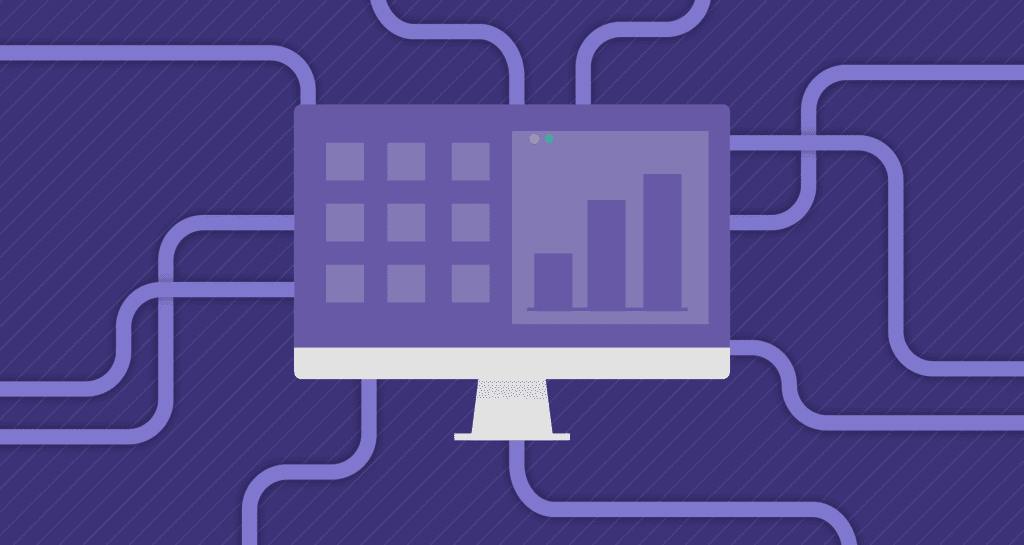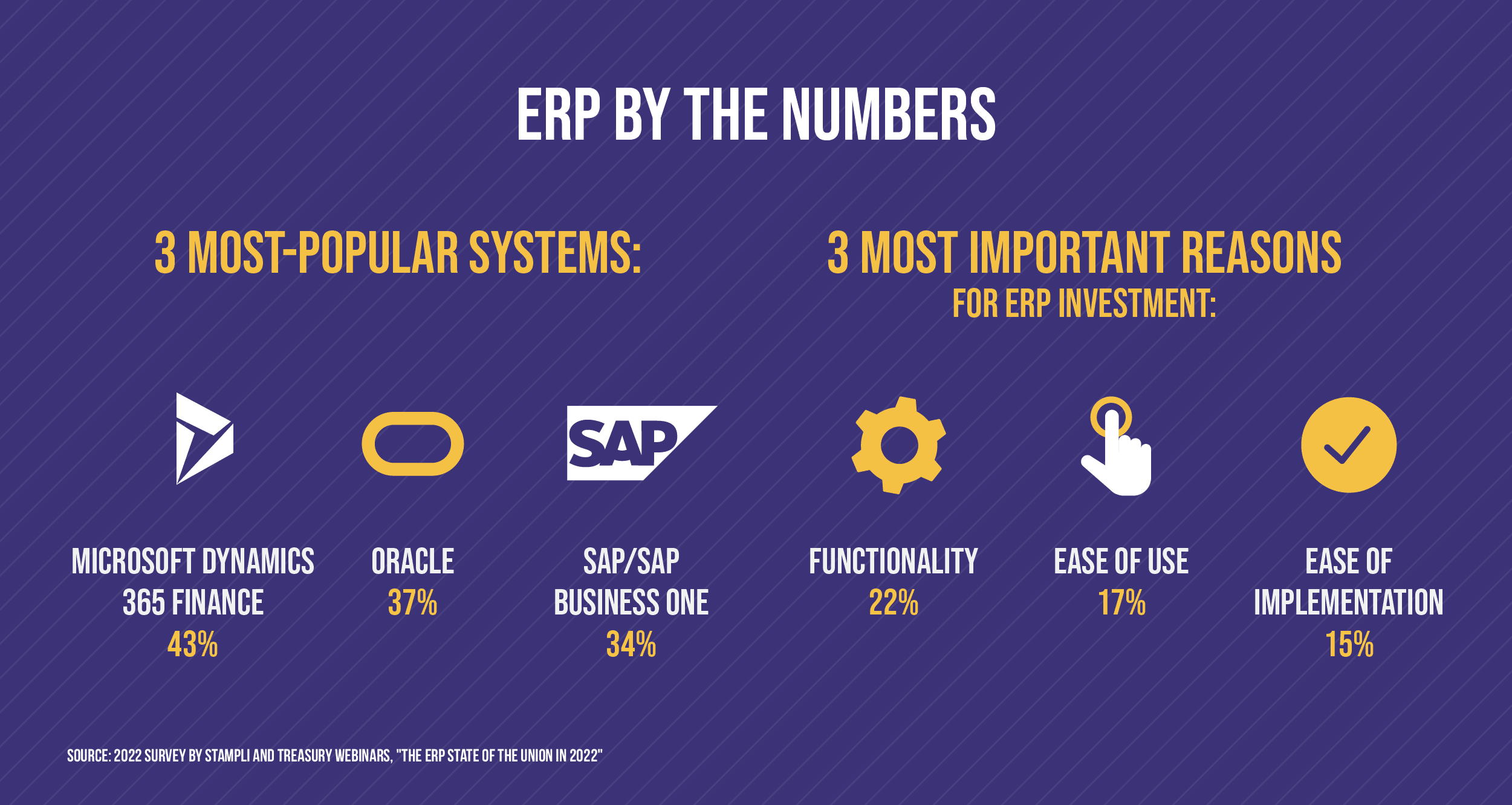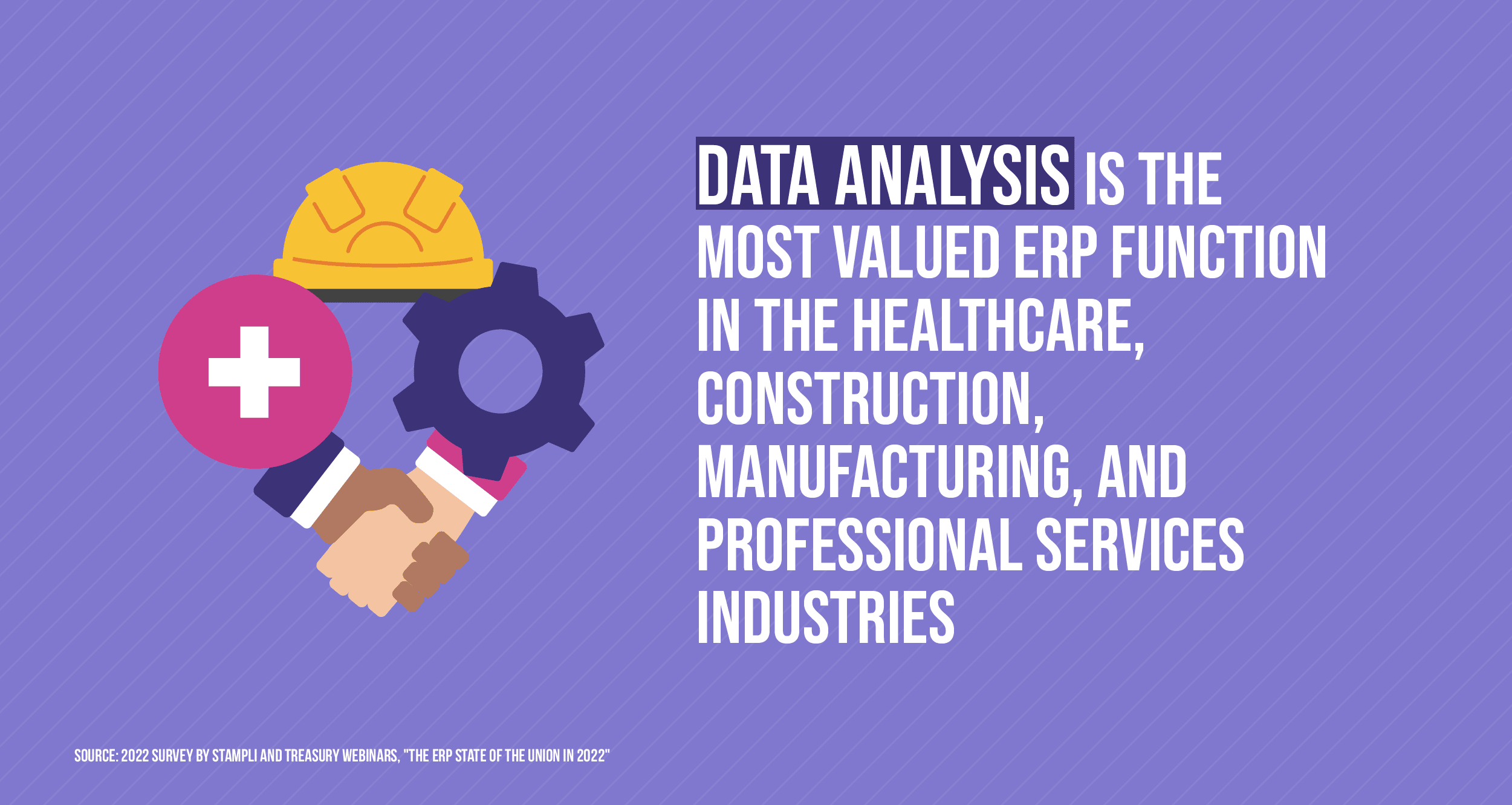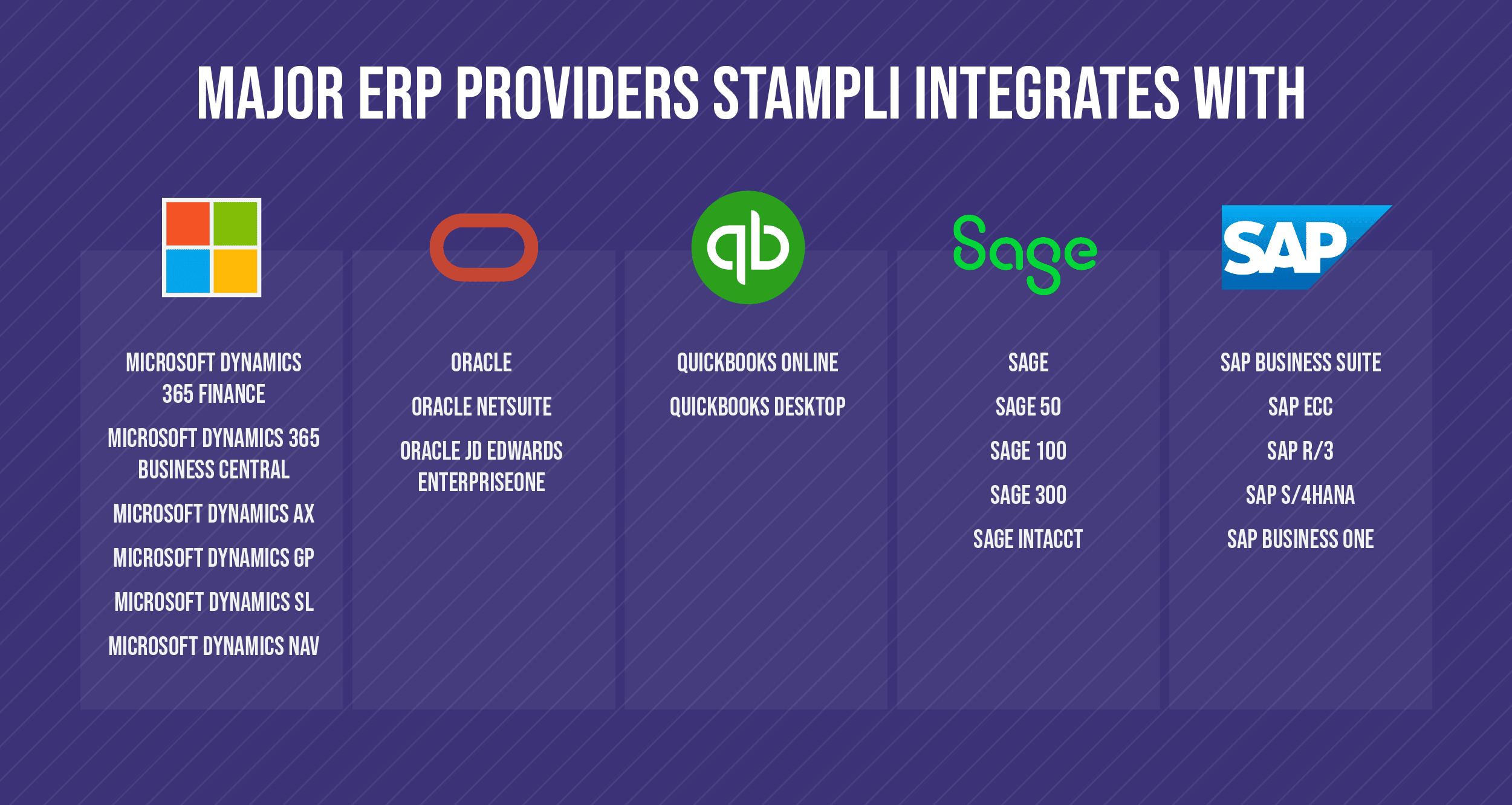Finding the Best ERP Tools for Your Business

Enterprise resource planning, or ERP systems can help business sizes from SMBs to large companies. Working as a central nervous system for businesses, ERPs help to connect different departments, manage company assets, organize accounting operations, and much more.
Not surprisingly, ERPs can require a significant investment of time and money to implement. As such, it’s important to know what ERPs can do, so users can take full advantage of their functionality.
Today, we’ll look at everything a business needs when it comes to ERP tools. These tools can include the systems themselves as well as standard modules and common add-ons. We’ll also look at why an AP automation platform like Stampli is so indispensable to an ERP system.
ERP Basics
In May 2022, Stampli and Treasury Webinars collaborated on a must-read survey, “The ERP State of the Union in 2022” of more than 900 finance and treasury personnels. While the survey was restricted to companies that use ERPs, the results were nevertheless illuminating. For example, the survey noted that 81% of respondents were with companies using at least two ERPs.
For companies in the know, ERPs can be a vital tool, helping businesses perform any number of different tasks across internal departments and company locations. More businesses seem to be catching on to the value of ERP software, with the global ERP market projected to reach close to $50 billion by 2025.
In this podcast episode, Rachita Sundar, SVP of Finance at HubSpot, explains how technology (including ERPs) can speed up and improve the planning process. As ERP systems become more common in business applications, here are a few basics to consider:
What ERP Systems Do and How They Work
Broadly speaking, enterprise resource planning systems provide a central hub for businesses that can touch many if not most parts of operations and business processes. SAP, one of the major ERP providers, notes that they are “often referred to as the system of record of the organization.” Functionality that ERPs can manage, SAP notes, includes “finance, HR, manufacturing, supply chain, services, procurement, and others.”
Historically, ERP software tended to be on-premises systems that were complicated to build, implement, and maintain. Naturally, this might have discouraged more businesses from making use of ERP solutions. The proliferation of cloud technology seems to be helping make ERPs more common, with just 24% of ERPs now solely on-premise, according to Stampli and Treasury Webinars’ ERP study.
The benefit for the 76% of companies that use ERPs in a cloud or hybrid environment (which includes software as a service, or SaaS-based ERP solutions) is that they can be at the ready as new features continue to drop and systems become more and more sophisticated. The trend toward cloud-based ERPs could also be helping to make ERP solutions more affordable.
The Major ERP Providers

Operating in recent years within both a reliable and burgeoning market like enterprise software, no shortage of ERP vendors have emerged. The top of the field is still controlled by some of the major players in tech, with Stampli and Treasury Webinars’ survey noting the following breakdown for which respondents were using which ERP systems:
- 43% were using Microsoft Dynamics 365 Finance;
- 37% were using Oracle;
- 34% were using SAP or SAP Business One;
- 32% were using Oracle NetSuite;
- 26% were using Workday;
- 25% were using Microsoft Dynamics GP;
- 12% were using Sage 100;
- 11% were using Infor;
- 10% were Sage Intacct.
There are a wealth of ERP platforms out there and a range of factors that guide companies toward selecting particular software solutions. The Stampli and Treasury Webinars’ ERP survey looked at the most important reason for a company’s ERP investment, finding:
- 22% were driven by the functionality;
- 17% cited ease of use;
- 15% cited ease of implementation;
- 15% cited the ability to within their business;
- 11% cited how well the ERP could integrate with existing software;
- And curiously, despite how expensive ERPs can be, only 8% cited price as the primary reason for choosing the particular software system that they did.
How Companies Deploy ERPs
Many companies won’t use just one ERP or have it at a sole location. As noted earlier, the vast majority of companies surveyed were using more than one ERP. In fact, nearly half of respondents – 43% to be precise – were using more than three ERP systems.
It’s worth noting, too, that there tends to be a pronounced difference in the number of ERPs leveraged between enterprise-level companies and SMBs. The study found 53% of large enterprises using at least four ERP systems, compared to 42% of mid-market firms, and 14% of small businesses.
When companies deploy an ERP, they often go all-in, knowing that a major investment lies ahead. If they get it right, the business can be transformed, with ERP applications able to help companies operate more efficiently over the course of the system’s lifecycle. But getting an ERP implementation right is also about knowing which modules, dashboards, and add-ons to insist upon.
ERP Tools: Modules and Add-Ons
When we talk about ERP tools, for our purposes we’re referring to one of three things. We can be referring to the overarching platforms themselves, which we covered above. Strictly speaking, ERP software like Microsoft Dynamics, Oracle, SAP, Sage, and others are all ERP tools.
That said, ERP tools can also refer to the modules or dashboards that come standard with some systems – though even the best ERPs can’t be expected to have every modular application – and add-ons that are common for business needs. This section covers ERP modules and add-ons that companies will likely want to prioritize.
3 Must-Have ERP Modules
Among the various things that Stampli and Treasury Webinars’ ERP study looked at was “the functionality that was supported by the most recent ERP” that companies had implemented.
The study identified the following as three of the most common features:
1. Data Analysis

In recent years, the value of data has become critically important in both business as a whole and within accounts payable and receivable departments. Today, companies expect to use data to:
- Streamline their efficiency profitability
- Operate as close to real-time as possible in their analysis
- Use data for forecasting or even predicting where things are trending
All of this can lead to better decision making, incorporating elements from the internet of things, or IOT, as ERPNews noted in June 2022.
Needless to say, ERP software can play a pivotal role in the B2B data revolution.“By accessing and transmitting rich data, including data from purchase orders and invoices, ERPs power the automation of payments,” an American Express executive told PYMNTS.com for a September 2022 piece about another intriguing trend – two-thirds of firms intend to automate routine tasks in the next year.
2. Accounting
One of the most valuable things an ERP can serve as is a repository for a company’s general ledger, which documents every transaction.
As we’ll note in a bit about the value of AP automation software, an ERP alone probably can’t digitize a company’s accounting or business operations. There are limits to what a general ledger can do within an ERP, such as the ability to pull in data from other systems or APIs or to convert foreign currencies that software like AP automation can do.
All the same, a general ledger in an ERP is a heck of a lot more accessible than a dusty ledger sitting on an old bookshelf in a back office or spreadsheets on a worn-out PC. The enhanced accounting capabilities and workflows of ERPs can also lead to better financial management, accounting, and provide more detailed financial reporting.
3. Tracking & Visibility
Businesses often have assets they don’t know they have, whether it’s extra inventory or vehicles and machines that are not continually in use. They can also have operational and supply chain management holes, breakdowns in their production planning, execution, or delivery that can thwart their profitability. Tools like solid warehouse management or material requirements planning can only do so much to address these issues.
ERPs provide a keen eye on everything, helping businesses have a much clearer view of their assets, inventory management, and business processes. It makes tracking and visibility much easier for companies. Business software like an ERP platform helps to make things essentially open-source and provides superior business management.
3 Common ERP Add-Ons
Even the best ERPs don’t come with everything. Here are three common ERP add-ons:
1. Customer Relationship Management
There’s a reason customer relationship management, or CRM tools such as Salesforce have become so ubiquitous in business in recent years. CRM platforms help companies close more deals, helping record information on existing and prospective clients. The software can even help with pricing guidance.
One thing that’s interesting about Salesforce is that companies sometimes try to use it as an ERP. A Salesforce CRM is not an ERP (or human resources, project management, or inventory management software, to name a few other ways CRM tools can get potentially misused.) By that same token, though, ERPs also aren’t CRMs. The two work best in tandem, each complementing one another’s robust business functions and workflows.
2. Data Visualization
As we noted earlier, ERPs act as a powerful repository of real-time data. That doesn’t mean, however, that ERPs will automatically have every business intelligence (EI) or illustration capability that a company needs to showcase its data.
Data visualization tools such as Microsoft Power BI can help companies take their data displays to the next level.
3. Accounts Payable Automation
A company with an ERP will probably have a more accurate and cleaner AP process than a company without one. Still, there’s going to be a lot the system can’t do without an add-on like AP automation. Here are some reasons why AP Automation is so valuable:
- If a company wants visibility from the moment an invoice arrives in an email inbox to after reconciliation
- If the business wants automatic payment approvals from mobile devices
- Firm wants fraud detection within its general ledger to be thorough and continuous, with AI and machine learning tools scouring countless transactions.
Save time, reduce the risk of errors, and prepare your business to scale using Stampli.
Why to Make Sure Stampli is One of Your ERP Tools
For any company that has an ERP system or is thinking about getting one, here are a few reasons to get an AP automation platform like Stampli in place.
Unmatched ERP Integrations

The enterprise resource planning software field is a vast, ever-evolving market, with different ERPs optimized for different uses.
One of the things we pride ourselves on at Stampli is that when it comes to ERPs, we don’t play favorites. Unlike some AP platforms that are restricted to only working with a select few ERPs, our AP software is pretty much unchecked in how many different ERP softwares it can work with easily.
We think it wise to be as positioned as best we can to help as much of the market as possible and want to work with companies no matter what ERP they’re using.
Your ERP Alone Might Not Optimally Do What We’re Best At
Our SaaS-based software that incorporates the latest in AI and machine learning boasts an incredible amount of functionality. We offer end-to-end invoice processing with an automated process from start to finish. It’s possible to pay bills, glean spend management insights, root out fraud, and much more, all within our platform.
ERP systems are generally powerful tools. But at least when it comes to accounts payable automation, they don’t typically come close to doing everything that Stampli can.
Using Stampli with a Best-In-Class ERP is a Powerful 1-2 Punch
At the end of the day, part of the reason that we work so well with so many different ERPs is that we want to help companies take advantage of the best ERPs.
We do this because we know that when Stampli and ERP are wielded in tandem, they make an unbelievable 1-2 punch, helping transform businesses.
Come learn more about why our AP automation platform is a must-have among ERP tools.